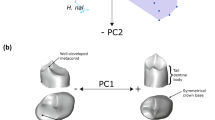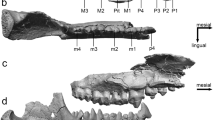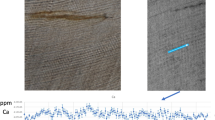Abstract
IN the course of a study of the European Hipparion1, it was found that the ratio of the length of the molar series to the length of the premolar series (M/P) is fairly constant within that genus. It ranges from 76.7 to 91 (M/P × 100) in thirty-eight specimens of upper tooth-rows from Pikermi and Salonica, most values falling between 80 and 89. It appears to be independent of the length of the tooth-row.
This is a preview of subscription content, access via your institution
Access options
Subscribe to this journal
Receive 51 print issues and online access
$199.00 per year
only $3.90 per issue
Buy this article
- Purchase on Springer Link
- Instant access to full article PDF
Prices may be subject to local taxes which are calculated during checkout
Similar content being viewed by others
References
Pirlot, P. L., “A Study of the European Hipparion”, University of London, Ph.D. thesis, 1948 (unpublished).
Osborn, H. F., Mem. Amer. Mus. Nat. Hist., N.S., 2, Pt. 1 (1918).
Osborn, H. F., U.S. Geol. Survey, Mon. 55, 2 vol. (1929).
Author information
Authors and Affiliations
Rights and permissions
About this article
Cite this article
PIRLOT, P. The Ratio Molars/Premolars in Perissodactyls. Nature 171, 972–973 (1953). https://doi.org/10.1038/171972a0
Issue Date:
DOI: https://doi.org/10.1038/171972a0
Comments
By submitting a comment you agree to abide by our Terms and Community Guidelines. If you find something abusive or that does not comply with our terms or guidelines please flag it as inappropriate.



